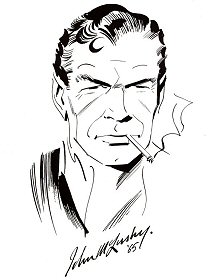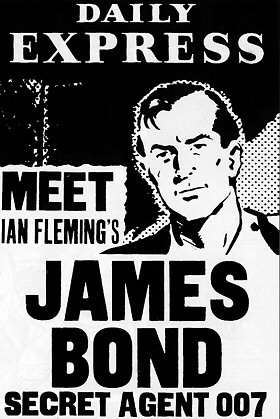 |
| |
James Bond comic strip artist John McLusky has died
at the age of 83. MI6 looks back at his life and career...
|
|
John McLusky (1923-2006)
8th September 2006
John McLusky, best known for his long tenure
as James Bond comic strip
artist, has died at the age of 83. He passed away on Tuesday 5th
September 2006. His prolific era as the official 007 artist spanned
eighteen James Bond adventures, producing an amazing 2,250 comic
strips.
Bond Begins
Four years before Sean Connery would bring 007 to the silver
screen with "Dr No", Daily Express readers in
the UK got their first sight of James Bond in 1958. The
face John McLusky gave to Bond would be many people's first
and lasting image of 007, including composer John Barry.
With this image so ingrained in the British
public's mind, it may even have helped the first Bond actor
land the part. One anecdote on his official
site notes that "Sean Connery, appearing in a theatre
production, was sitting in his dressing room with another
fellow actor who was reading a copy of the Daily Express.
This gentleman remarked to Sean how he felt that he should
play the part of Bond as he looked remarkably like the face
in the strip cartoon."
Right: John McLusky's iconic representation
of 007 |
|
 |
Although initially reluctant, Ian Fleming finally
granted permission to the London Daily Express to create a syndicated
series of comic strips based on his novels. Despite having been
a journalist for the Express himself, Fleming hesitated to accept
the offer because he was worried that his creation would devalue,
and had concerns about other writers transposing his stories to
the new format.
 Above: The first ever James Bond comic
strip showing the opening of the debut story "Casino
Royale".
Above: The first ever James Bond comic
strip showing the opening of the debut story "Casino
Royale". |

Above: The first promo poster released
by the Daily Express in 1958 |
|
Edward Pickering, then editor of the
Express, persuaded Fleming that the comic strips would be
a "Rolls Royce" of a series with Anthony Herne
to adapt the series, who had previously serialised some
of Fleming's novels for publication in the Express.
Fleming's first James Bond novel "Casino
Royale" would also become the starting point for the
newspaper series, with the first strip published on July
7th 1958. Staff writer Anthony Hearne adapted the novel,
and John McLusky was brought in to illustrate.
Licence To Draw
The artist, previously a British Royal Air Force Bomber
Command in World War II, was asked to supply a sample comic
strip of what James Bond would look like before he won the
contract for the strip series.
He chose to illustrate a scene from "From
Russia With Love" in which Bond and Red Grant fight
on the Orient Express. Fleming approved of the sample and,
shortly afterwards, the first publicity material began to
appear from the Daily Express, announcing the start of Casino
Royale.
|
Initially sticking closely to Fleming's source
material, the strips created by Hearne and McLusky were an instant
success and boosted sales of the newspaper. Fleming's concerns
were eased when the flow of the stories, although only read at
a rate of three cells a day, kept readers hooked despite losing
a lot of Fleming's detailed prose from the original material.
The punchy, fast-paced style and daily "cliff-hangers"
suited Bond's adventures perfectly.

 Top: A panel from McLusky's test piece
that won him the the licence to draw in 1958.
Top: A panel from McLusky's test piece
that won him the the licence to draw in 1958.
Bottom: The published version from the same scene released
in 1960. |
McLusky began his work on the strips based in
a drawing room in his London family home, a small ground floor
studio flat off Earl's Court Road. A couple of years later, when
the strips were enjoying huge success, McLusky relocated his family
to a country property containing four cottages, three of which
would become his studio.
His grueling schedule would be to complete
one strip of the series a day, for six days a week. This
included finding reference photographs, initial sketches,
producing the final artwork and running the strip past his
two sons for criticism and error checking.
Stripping Bond
McLusky teamed up with writer Henry Gammidge for the following
seven years, recreating Fleming's novels and short stories
in the graphic form almost chronologically (except for a
one-off partnership of writer Peter O'Donnell with McLusky
for 1960's "Dr. No" adaptation).
Right: An iconic image of Bond from a cell
in the 1959 adventure "Diamonds Are Forever"
|
|
 |
Trouble broke out in 1962 however, when Fleming
published his short story "The Living Daylights" in
rival newspaper The Sunday Times. Express owner Lord Beaverbrook
was angered and abruptly curtailed the publication of the current
strip "Thunderball", which was only two months into
syndication. Kevin McClory, a thorn in the side of many future
Bond productions, also began his first legal action against Fleming
for rights on "Thunderball", which he co-wrote. Eventually
a settlement was bashed out between Fleming and McClory, allowing
the Express to continue publication of Fleming's other works in
1964 - restarting with "On Her Majesty's Secret Service".
 Above: The opening panel of aborted
Thunderball strip.
Above: The opening panel of aborted
Thunderball strip. |
Thirteen adventures since the Express began publishing
Bond strips back in 1958, Gammidge and McLusky stepped aside for
the new team of Jim Lawrence and Yaroslav Horak as writer and
artist respectively. In 1981, series writer Lawrence was then
paired with the original strip artist John McLusky returning for
a further four adventures.
To celebrate his John McLusky's work, his sons
Graham and Sean (and his Wife, Kate) organised an exhibition of
his work at the Barbican in London entitled "The Face of
James Bond". It took place from 25th November 1995 to 14th
January 1996 and featured an exhibit of his original Bond strip
cartoon work.
As well as his long run as James Bond
comic strip artist, McLusky also drew strips such as "Secret
Agent 13" for Fleetway's "June" and illustrations
for "Look and Learn", and also worked for 15 years
on "TV Comic" with strips such as "Orlando",
"Laurel & Hardy" and "Pink Panther".
In the early 1980's he worked on Thames TV series "Hattytown".
He the retired but was lured back in to action in 1986 when
Gerald Lip, the Express strip Editor, asked him to draw
the last James Bond strips, which he did for three years.
He then regularly lectured in the History of Art and was
also a Punch and Judy Professor and Puppeteer. He spent
his final years taking it easy at his home due to heath
reasons but enjoyed reading, meeting his friends and listening
to his favourite Jazz collections.
|
|
Hearn on McLusky
Comic strip scriptwriter Anthony
Hearn wrote in 1990 about his work on Bond with McLusky,
"I trusted John McLusky to make pictorial sense
of my scenario. Fleming tended to choose, for his
high dramatic points, locations which he himself knew
well: high class hotels, rich men's gambling haunts.
John beavered away getting pictorial references for
the many background 'shots' needed to establish the
scene. His artwork was vastly superior to my script.
It was that which ensured the wide following for the
Bond Strip after a shaky start.
|
|
The Legend Lives On
John McLusky will be best remembered for giving to the world "the
face of James Bond", and with Titan
Books republishing the original strips, fans old and new can
enjoy the adventures again. McLusky's work will forever hold resonance
in the Bond canon, and is as fresh and exciting today as it was
nearly fifty years ago.
Related Articles
 Comic Strip Coverage
Comic Strip Coverage
 Titan
Books James Bond Collections
Titan
Books James Bond Collections